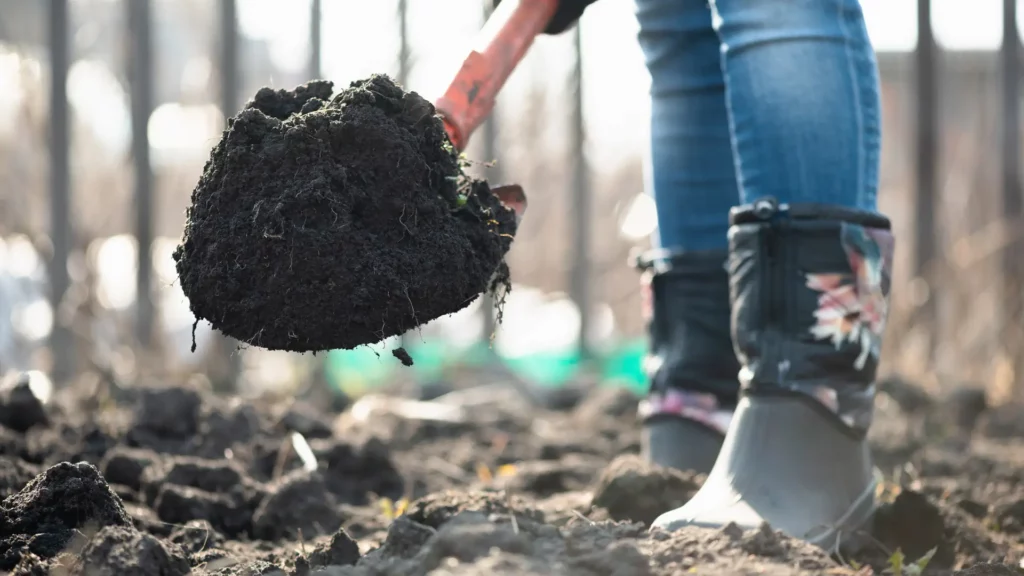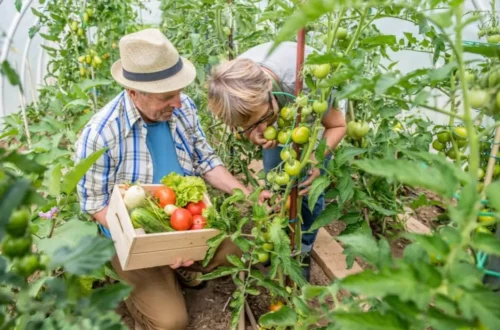The Ultimate Guide to Preparing Your Garden Soil for the Next Year

Are you ready to take your gardening to the next level? Imagine lush, vibrant plants and a bountiful harvest. It all starts with one crucial step: preparing your garden soil for the coming season.
Your garden soil is the foundation for success. It’s the key to unlocking your plants’ full potential and ensuring healthy growth. But where do you begin? How do you optimize your soil’s fertility and create the perfect growing environment?
In this ultimate guide, we’ll walk you through everything you need to know about preparing your garden soil. From techniques to improve soil quality, to removing weeds and pests, to adding organic amendments for optimal plant growth – we’ve got you covered. We’ll even show you how to test and adjust soil pH and nutrient levels, and protect your soil from erosion during the off-season.
Don’t let poor soil hinder your gardening dreams. Read on as we dive deep into the world of garden soil and equip you with the knowledge and tools you need for a successful season ahead.
Introduction to Preparing Garden Soil for Next Year
Preparing your garden soil for the upcoming growing season is a crucial step in ensuring successful and productive gardening. By dedicating some time and effort now, you can create an optimal growing environment and set the stage for healthy plants and abundant yields.
The importance of preparing your garden soil cannot be overstated. When you properly prepare the soil, you improve its fertility, texture, and overall health. This allows plants to establish strong root systems, access necessary nutrients, and resist diseases and pests more effectively. Additionally, well-prepared soil promotes better water drainage, aeration, and nutrient absorption, leading to healthier and more vigorous plant growth.
By investing in soil preparation now, you lay the foundation for a successful gardening season. It’s like giving your plants a head start, setting them up for optimal growth and development. The efforts you put into your garden soil now will pay dividends in the form of bountiful harvests and thriving plants.
In the following sections, we will explore the key steps and techniques to prepare your garden soil effectively. From clearing the garden area to amending the soil with organic matter and testing and adjusting soil pH and nutrient levels, we will provide you with expert recommendations to take your gardening to the next level.
Also read: Essential Steps for Preparing Soil for Blueberry Plants
The Role of Soil Quality in Gardening Success
Having good garden soil is the foundation for successful and productive gardening. The quality of your soil directly impacts the health and growth of your plants, as well as the overall yield of your garden. By understanding the key characteristics of good garden soil and its importance, you can ensure that your plants thrive and reap bountiful harvests.
Key Characteristics of Good Garden Soil
1. Fertility: Good garden soil is rich in nutrients necessary for plant growth. It contains essential elements like nitrogen, phosphorus, and potassium to support healthy development.
2. Well-Drained: Proper drainage is crucial to prevent waterlogging and root rot. Good garden soil allows excess water to flow through while retaining enough moisture for plants to access.
3. Texture: Ideal garden soil has a balanced texture, containing a mixture of sand, silt, and clay. This allows for adequate water retention, aeration, and root penetration.
4. pH Balance: Soil pH affects nutrient availability to plants. Most vegetables prefer a slightly acidic to neutral pH range of 6.0 to 7.0. Testing and adjusting soil pH ensures optimal nutrient uptake.
5. Organic Matter: The presence of organic matter, such as compost or well-rotted manure, improves soil structure, enhances nutrient retention, and promotes beneficial microbial activity.
6. Absence of Weeds and Pests: Good garden soil is free from persistent weeds and harmful pests that can compete with or damage plants. Regular soil maintenance and pest control measures are essential.
Importance of Good Garden Soil
1. Nutrient Supply: Healthy soil provides a steady supply of nutrients to plants, supporting their growth, development, and overall vigor. This leads to higher yields and better-quality produce.
2. Water Management: Proper soil structure and composition enable efficient water uptake and retention by plant roots. This reduces the risk of both water stress and waterlogging.
3. Root Development: Good garden soil allows roots to spread and penetrate easily, promoting strong root systems for plants. Robust roots ensure optimal nutrient absorption and stability.
4. Disease Resistance: Well-nourished and properly drained soil strengthens plants, making them less susceptible to diseases and infections.
5. Environmental Impact: Healthy garden soil contributes to a sustainable ecosystem by reducing erosion, improving water quality, and sequestering carbon.
By prioritizing soil quality through regular testing, amendment, and maintenance, you lay the groundwork for a thriving garden. Invest time and effort into preparing your garden soil, and you will reap the rewards of a flourishing and fruitful growing season.
Remember, good garden soil is the bedrock upon which successful gardening is built. Take the time to understand and improve your soil quality, and you’ll set yourself up for gardening success.
Also read: The Ultimate Guide to Preparing Soil for Sod Installation
Clearing and Cleaning the Garden Area
To ensure a healthy and productive garden in the upcoming season, it is important to start with a clean and clear garden area. Follow these instructions to remove weeds, debris, and other unwanted materials:
1. Weed removal: Begin by manually pulling out any visible weeds from the garden beds. Make sure to remove the entire root system to prevent regrowth.
2. Debris and plant residue: Clear out any fallen leaves, twigs, or dead plants from the garden beds. This helps prevent pest infestations and creates a clean environment for new growth.
3. Turn the soil: Use a spading fork or garden tiller to turn the soil, breaking up large clods and incorporating any remaining plant material into the soil. This improves soil structure and allows for better nutrient absorption.
4. Remove rocks and debris: Remove any rocks, stones, or other debris that may hinder plant growth or interfere with garden maintenance.
By clearing and cleaning your garden area, you create a fresh start for the next growing season and reduce the risk of weed and pest problems. Remember to dispose of weeds and debris properly to prevent reinfestation.
Also read: The Ultimate Guide to Preparing Soil for Grass Seed
Amending Soil with Organic Matter
One of the most effective ways to improve soil fertility is by amending it with organic matter. Organic amendments, such as compost or other decomposed plant materials, can provide numerous benefits for your garden soil.
Benefits of Organic Amendments:
1. Enhanced Nutrient Content: Organic matter is rich in essential nutrients that plants need for healthy growth. By adding organic amendments, you can increase the nutrient content of your soil, providing a steady supply of nourishment for your plants.
2. Improved Soil Structure: Organic matter helps improve soil structure by promoting better drainage and aeration. It helps soil retain moisture while also preventing it from becoming waterlogged, ensuring optimal growing conditions for plants.
3. Increased Microbial Activity: Organic amendments support the growth and activity of beneficial soil microorganisms. These microorganisms break down organic matter, releasing nutrients in a form that plants can readily absorb.
4. Enhanced Water Holding Capacity: Organic matter acts like a sponge, absorbing water and slowly releasing it to plant roots. This helps in maintaining consistent moisture levels in the soil, especially during dry periods.
Recommendations for Adding Organic Matter:
1. Compost: Compost is a valuable organic amendment that you can easily make at home using kitchen scraps, yard waste, and other organic materials. Spread a layer of compost over your garden beds and mix it into the top few inches of soil.
2. Manure: Well-composted animal manure, such as cow or chicken manure, is another excellent option for organic soil amendment. Make sure the manure has been properly composted to eliminate any potential weed seeds or pathogens.
3. Cover Crops: Sow cover crops, such as legumes or winter rye, after harvesting your crops. These plants can be tilled into the soil to add organic matter and improve soil fertility.
Remember to apply organic amendments in appropriate quantities based on the specific needs of your soil. Regularly adding organic matter will gradually improve the overall quality and fertility of your garden soil, leading to healthier plants and abundant yields.
Also read: The Ultimate Guide to Fertilizing Soil for Healthy Plant Growth
Testing and Adjusting Soil pH and Nutrient Levels
Maintaining optimal soil pH and nutrient levels is crucial for healthy plant growth and maximum yields. By testing your garden soil and making necessary adjustments, you can ensure that your plants have access to the right nutrients they need to thrive.
Importance of Testing Soil pH and Nutrient Levels
Testing soil pH helps determine the acidity or alkalinity of your soil, which directly affects nutrient availability. Different plants have different pH preferences, so it’s essential to adjust the pH accordingly. Additionally, testing for nutrient levels allows you to identify any deficiencies or excesses that may hinder plant growth.
Guidance on Adjusting Soil pH and Nutrient Levels
If the soil pH is too high (alkaline), you can lower it by adding organic matter such as peat moss or elemental sulfur. On the other hand, if the pH is too low (acidic), you can raise it by adding lime or wood ashes. When it comes to nutrient adjustments, you can use organic fertilizers or specific mineral-based fertilizers to address deficiencies or excesses.
Remember to follow the recommended application rates and guidelines provided by reputable sources or conduct a soil test through your local agricultural extension office. Regularly monitoring and adjusting soil pH and nutrient levels will help optimize plant health and abundance.
- Organic matter: Compost, manure, and other decomposed plant or animal materials that enrich soil fertility.
- Alkaline: Having a pH value greater than 7, indicating basicity.
- Acidic: Having a pH value less than 7, indicating acidity.
Also read: The Ultimate Guide to Soil Preparation for Your Garden
Mulching and Protecting Soil During the Offseason
Mulching is a crucial practice for protecting garden soil during the offseason. It offers numerous benefits that contribute to soil health and plant growth. By implementing the right mulch types and applying them correctly, you can safeguard your soil and set the stage for a thriving garden in the coming season.
Benefits of Mulching
1. Moisture Conservation: Mulch acts as a barrier, reducing evaporation and maintaining soil moisture levels. This is particularly important during dry periods when water availability may be limited.
2. Weed Suppression: A layer of mulch inhibits weed growth by smothering weed seeds and blocking their access to sunlight. This helps reduce the competition for nutrients and water between weeds and your plants.
3. Temperature Regulation: Mulch acts as insulation, regulating soil temperature by keeping it cooler in hot weather and warmer during colder periods. This helps create a more stable environment for your plants’ root systems.
Recommended Mulch Types
1. Organic Mulch: Options such as straw, wood chips, or compost provide additional benefits by gradually breaking down and enriching the soil with organic matter, improving its fertility.
2. Inorganic Mulch: Materials like landscape fabric, plastic sheeting, or gravel can be used for long-lasting weed control and moisture retention. However, they do not contribute to soil improvement like organic mulches.
Application Methods
1. Apply a layer of mulch around plants, leaving a small gap around the plant stem to prevent moisture buildup and potential rot.
2. Maintain a mulch depth of 2 to 4 inches for optimal performance and effectiveness. Avoid piling mulch directly against plant stems.
3. Replenish mulch as needed throughout the offseason to maintain the desired thickness and reap the full benefits of mulching.
Remember, the type and amount of mulch required may vary depending on your specific garden conditions and plant preferences. Consider consulting local gardening resources or experts for tailored recommendations.
By prioritizing mulching and protecting your garden soil during the offseason, you can create an environment that promotes healthy plant growth, prevents weed infestations, and contributes to long-term soil fertility.
Also read: The Ultimate Guide to Making Organic Soil for a Healthy Vegetable Garden
Conclusion
Preparing your garden soil for the next growing season is crucial for the success and productivity of your garden. By following these expert recommendations, you can optimize your soil’s fertility, prevent weed and pest problems, and create an ideal growing environment for your plants. Remember, healthy soil is the foundation of a thriving garden. So start clearing and cleaning your garden area, amend the soil with organic matter, test and adjust soil pH and nutrient levels, and protect the soil with proper mulching during the off-season. By taking these steps, you’ll ensure that your garden soil is in the best possible condition for the coming season. Happy gardening!





